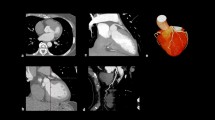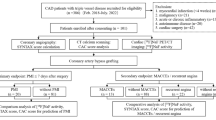Abstract
Background: The use of acute Tc-99m sestamibi imaging has provided a valuable methodology to assess myocardium at risk and collateral blood flow. Objective: The purpose of this study was to determine the impact of physical, physiologic, and reconstruction factors on the extent and severity of Tc-99m sestamibi images in a porcine model of coronary occlusion and reperfusion. Methods and results: Eleven pigs underwent 40 min of coronary occlusion using a balloon catheter followed by reperfusion. Radiolabeled microspheres were injected during occlusion for blood flow determination and 20–30 mCi of Tc-99m sestamibi was injected intravenously for cardiac imaging. Each animal underwent four modes of gamma camera imaging: a cardiac and respiratory gated SPECT study, an ungated SPECT study, a post-mortem SPECT study and an ex-situ study where the heart was sliced into five short axis slices and directly imaged. All animals had extensive wall motion abnormalities at the time of imaging. Myocardial risk area by ex-situ imaging was 32 ± 9% LV and did not significantly change with the addition of a chest cavity and tomographic reconstruction (post-mortem and gated imaging) or cardiac and respiratory motion (ungated imaging). Defect severity was significantly underestimated with the addition of a chest cavity and tomographic reconstruction but was unaltered by cardiac and respiratory motion. Conclusions: The assessment of risk area acutely by SPECT Tc-99m sestamibi imaging is unaffected by cardiac motion obviating the necessity for gated imaging. Estimated defect severity (which has been used as a measure of collateral flow) is significantly reduced by the chest wall and tomographic acquisition and reconstruction suggesting a role for scatter and attenuation algorithms for this measure.
Similar content being viewed by others
References
Gewirtz H. The influence of left ventricular volume and wall motion on myocardial images. Circulation 1979; 59: 1172-1177.
Parodi O, Schelbert HR, Schwaiger M, Hansen H, Selin C, Hoffman EJ. Cardiac emission computed tomography: underestimation of regional tracer concentrations due to wall motion abnormalities J Comput Assist Tomogr 1984; 8: 1083-1092.
Bartlett ML, Bacharach SL, Voipio-Pulkkii LM, Dilsizian V. Artifactural inhomogeneities in myocardial PET and SPECT scans in normal subjects. J Nucl Med 1995; 36: 188-195.
Sinusas AJ, Shi QX, Vitols PJ, et al. Impact of regional ventricular function, geometry and dobutamine stress on quantitative 99m Tc-sestamibi defect size. Circulation 1993; 88: 2224-2234.
Hoffman EJ, Huang SC, Phelps ME. Quantitation in positron emmision computed tomography: 1. Effect of object size. J Comput Assist Tomogr 1979; 3: 299-308.
Eisner RL, Schmarkey S, Martin SE, et al. Defects on SPECT \lsPerfusion\rs images can occur due to abnormal segmental contraction. J Nucl Med 1994; 35: 638-643.
Maddahi J, Kiat H, VanTrain K, et al. Myocardial perfusion imaging with technetium-99m sestamibi SPECT in the evaluation of coronary artery disease. Am J Cardiol 1990; 66: 55E-62E.
Galt JR, Cullum SJ, Garcia EV. SPECT quantification: a simplified method of attenuation and scatter correction for cardiac imaging. J Nucl Med 1992; 32: 1813-1820.
Gibbons RJ, Verani MS, Behrenbeck T, et al. Feasibility of tomographic Tc-99m-Hexakis-2-Methoxy-2-Methylpropyl-Isonitrile imaging for the assessment of myocardial area at risk and the effect of treatment in acute myocardial infarction. Circulation 1989; 80: 1277-1286.
Wackers FJT, Gibbons RJ, Verani MS, et al. Serial quantitative planar technetium-99m-isonitrile imaging in acute myocardial infarction: efficacy for noninvasive assessment of thrombolytic therapy. J Am Coll Cardiol 1989; 14: 861-873.
Gibbons RJ, Holmes DR, Reeder GS, Bailey KK, Hopfenspirger MR, Gersh BJ. Immediate angioplasty compared with the administration of a thrombolytic agent followed by conservative treatment for myocardial infarction. N Engl J Med 1993; 328: 685-691.
Schaer GL, Spaccavento LJ, Browne KF, et al. Beneficial effects of Rheoth Rx injection in patients receiving thrombolytic therapy for acute myocardial infarction. Results of a randomized, double blind, placebo-controlled trial. Circulation 1996; 94: 298-307.
Christian TF, O'Connor MK, Glynn RB, Rogers PJ, Gibbons RJ. The influence of gating on measurements of myocardium at risk and infarct size during acute myocardial infarction by tomographic Tc-99m labeled sestamibi imaging. J Nucl Cardiol 1995; 2: 207-216.
Ter-Pogossian MM, Bergmann SR, Sobel BE. Influence of cardiac and respiratory motion on tomographic reconstructions of the heart: implications for quantitative nuclear cardiology. J Comput Assist Tomogr 1982; 6: 1148-1155.
Christian TF, Gibbons RJ, Gersh BJ. Effect of infarct location on myocardial salvage assessed by technetium-99m isonitrile. J Am Coll Cardiol 1991; 17: 1303-1308.
O'Connor MK, Hammel T, Gibbons RJ. In vitro validation of a simple tomographic technique for the estimation of percentage of myocardium at risk using methoxyisobutyl isonitrile technetium-99m (sestamibi). Eur J Nuc Med 1990; 17: 69-76.
Christian TF, Schwartz RS, Gibbons RJ. Determinants of infarct size in reperfusion therapy for acute myocardial infarction. Circulation 1991; 83: 739-746.
Schiller NB, Shah PM, Crawford M, et al. Recommendations for quantitation of the LV by 2D echocardiography: committee on standards, subcommittee on quantitation of 2D echocardiograms. J Am Soc Echo 2: 358-367.
Sinusas AJ, Watson DD, Cannon JR Jr, Beller GA. Effect is ischemia and post-ischemic dysfunction on myocardial uptake of technetium-99m labeled methoxyisobutyl isonitrile and thallium-201. J Am Coll Cardiol 1989; 14: 1785-1793.
Domenech RJ, Hoffman JIE, Nole MIM, Saunders KB, Henson JR, Subijanto S. Total and regional coronary blood flow measured by radioactive microsphere in conscious and anesthesized dogs. Circ Res 1969; 25: 581-596.
Reimer KA, Jennings RB, Cobb FR, et al. Animal models for protecting ischemic myocardial: results of the NHLBI cooperative study. Comparisons of unconscious and conscious dog models. Circ Res 1985; 56: 651-665.
Christian TF, O'Connor MK, Schwartz RS, Gibbons RJ, Ritman EL. A noninvasive Tc-99m sestamibi-based method to assess coronary flow during acute myocardial infarction: evaluation in closed chest animal models of coronary artery occlusion with reperfusion. J Nucl Med 1997; 38: 1840-1846.
Bland JM, Altman DG. Statistical methods for assessing agreement between two methods of clinical measurement. Lancet 1986; 1: 307-310.
Bland JM, Altman DG. Comparing methods of measurement: why plotting difference against standard method is misleading. Lancet 1995; 246: 1085-1087.
Tatum JL, Jesse RL, Kontos MC, et al. A comprehensive strategy for the evaluation and triage of the chest pain patient. Ann Emerg Med 1997; 29: 168-171.
Chareonthaitawee P, Christian TF, O'Connor MK, et al. Noninvasive prediction of residual blood flow within the risk area during acute myocardial infarction: a multicenter validation study of patients undergoing direct coronary angioplasty. Am Heart J 1997; 134: 639-646.
Tsui BM, Zhao X, Frey EC, McCartney WH. Quantitative single-photon emission computed tomography: basics and clinical considerations. Seminars in Nuclear Medicine 1994; 24: 38-65.
O'Connor MK, Caiati C, Christian TF, Gibbons RJ. Effects of scatter correction on the measurement of infarct size from SPECT cardiac phantom studies. J Nucl Med 1995; 36: 2080-2086.
Hoffman EJ, Phelps ME. Positron emission tomography: principles and quantitation. In: Phelps ME, Mazziotta JC, Schelbert HR, editors. Positron Emission Tomography and Autoradiography. New York: Raven Press, 1986, 237-286.
He ZX, Scarlett MD, Mahmarian JJ, Verani MS. Enhanced accuracy of defect detection by myocardial single photon emission computed tomography with attentuation correction with gadolinium 153 line sources. Evaluation with a cardiac phantom. J Nuc Cardiol 1997; 4: 202-210.
Author information
Authors and Affiliations
Rights and permissions
About this article
Cite this article
Das, A.K., O'Connor, M.K., Gibbons, R.J. et al. A systematic analysis of factors which may impact upon tomographic perfusion imaging measurements: Implications for the use of Tc-99m sestamibi in acute myocardial infarction. Int J Cardiovasc Imaging 16, 293–303 (2000). https://doi.org/10.1023/A:1026508429309
Issue Date:
DOI: https://doi.org/10.1023/A:1026508429309




